Yandi Mausoleum Scenic Area is located on Luyuan Slope, 19 kilometers west of Yanling County Seat in Zhuzhou City, Hunan Province. As the sacred resting place of Emperor Yan Shennong, a founding ancestor of the Chinese nation, it is hailed as "the Most Prestigious Mausoleum in China". The scenic area covers a planned total area of 122.5 square kilometers, with 3.6 square kilometers open to tourists. As a national 5A-level tourist attraction, it is also a Major Historical and Cultural Site Protected at the National Level, a National Scenic Area, a National Patriotic Education Demonstration Base, and a Cross-Strait Exchange Base. It also ranks first among Hunan Province's "Top Ten Cultural Landmarks". The scenic area mainly consists of five functional zones: the Worship Zone (Shennong Grand Hall), the Pilgrimage Zone (Yandi Mausoleum Hall), the Commemoration Zone (Shennong Garden), the Huangshan Scenic Zone and the Mishui River Scenic Belt, boasting over 110 natural, historical and cultural landscapes. It lies in the subtropical monsoon humid climate zone, surrounded by mountains. Most of the scenic area features hills, mounds, river valleys and plains, with an overall terrain sloping from south to north.
History and Culture
Emperor Yan Shennong was the leader of the Jiang clan tribe in the ancient times. As the founder and founder of China's farming culture, he made remarkable achievements. He invented the plow and taught people to cultivate crops; he tasted hundreds of herbs and pioneered traditional Chinese medicine; he wove hemp into cloth to help people cover their bodies; he initiated the practice of market trading at noon; he promoted farming and pottery-making and built the Mingtang (a ritual hall); he carved paulownia wood into musical instruments and started the La Festival (a sacrificial ceremony at the end of the year); he bent wood into bows and sharpened wood into arrows. He made pioneering contributions to the rise and reproduction of the Chinese nation. In his later years, Emperor Yan traveled to Hunan to collect medicinal herbs for treating people's illnesses. Unfortunately, he accidentally ate "heartbreak grass" and passed away. He was buried at "the western end of Changsha's tea-growing area", which is now Luyuan Slope in Luyuan Town, Yanling County, Zhuzhou City, Hunan Province.
The mausoleum of Emperor Yan dates back to the ancient times, and it was further developed into a formal mausoleum during the Western Han Dynasty. Sacrificial activities flourished in the Tang Dynasty. In the fifth year of the Qiande reign in the Song Dynasty (967 AD), a temple was built in front of the mausoleum, and a statue of Emperor Yan was enshrined for worship. A regular sacrificial tradition was established, stating that "a grand sacrifice shall be held once every three years as a permanent practice". After that, there were as many as 51 stone steles inscribed with sacrificial texts from successive dynasties, along with more than 20 other stone tablets and carvings. The Yandi Mausoleum Temple underwent renovations of varying scales during the Song, Ming and Qing dynasties—once in the Song Dynasty, three times in the Ming Dynasty and nine times in the Qing Dynasty. It was also renovated four times during the Republic of China. After the founding of the People's Republic of China, the mausoleum has undergone multiple renovations and maintenance. Since its renovation and opening to the public in 1988, it has received more than 10 million tourists from home and abroad, including over 800,000 tourists from Hong Kong, Macao and Taiwan, overseas Chinese and international friends. More than 30 Party and state leaders, including Jiang Zemin, Hu Yaobang and Chen Yun, have inscribed inscriptions for Yandi Mausoleum in their own handwriting. Over 20 Party and state leaders have made special trips to pay homage to the mausoleum and guide its construction work. Since the resumption of official sacrificial activities in 1993, large-scale sacrificial ceremonies have been held annually. In 2006, the "Yandi Mausoleum Sacrifice Ritual" was included in the first batch of the National Intangible Cultural Heritage List.
Major Attractions
Yandi Mausoleum Hall
Modeled after the architectural style of the imperial palaces in the Qing Dynasty, Yandi Mausoleum Hall faces south, with its main buildings arranged symmetrically along the north-south central axis and stone tablet houses flanking the east and west sides. It stretches 104 meters from north to south and 40.5 meters from east to west, covering a floor area of 4,212 square meters, and consists of five courtyards. The first courtyard is the Meridian Gate, which serves as the main gate of the mausoleum. In front of the gate lies a 50×50-meter pilgrimage square, with an arch-shaped Jijin Gate and a rectangular side gate on the left and right respectively. In the center of the Meridian Gate stands a white marble stele inscribed with "Yandi Mausoleum" by Jiang Zemin. A coiled dragon stone platform is inlaid in front of the stele, and granite carvings of a mountain eagle and a white deer stand on both sides. The second courtyard is the Ritual Pavilion, a place for offering sacrifices to the ancestor. Adopting a gabled roof, the pavilion is 14.03 meters wide, 5.53 meters deep and 8.33 meters high. A plaque with the words "Ancestor of the Nation, His Light Shines Upon the World" written by Zhou Peiyuan hangs in the pavilion. A stone platform carved with two dragons playing with a pearl is inlaid in front of the pavilion, and incense burners and candlesticks are placed inside for ritual ceremonies. On both sides of the Ritual Pavilion are stone tablet houses, which collect 8 remaining stone steles with sacrificial texts from past dynasties. The third courtyard is the main Mausoleum Hall, with a double-eave gable and hip roof. It is 21.16 meters wide, 16.94 meters deep and 19.33 meters high, covering an area of 358.5 square meters. The hall is supported by 30 granite pillars each with a diameter of 60 centimeters. The upper and lower eaves are decorated with colorful bracket sets with single upturned arms, and the corners of the main ridge are adorned with mythical sea creature and beast-shaped decorations. The ceiling of the hall is painted with golden dragon patterns and dragon-grass patterns, totaling 9,999 painted dragons. A granite shrine platform is placed in the center of the hall, on which a sandalwood shrine stands, enshrining a golden statue of Emperor Yan with the inscription "The Primordial Ancestor" above it. The stone platform in front of the hall is a white marble relief depicting a lying dragon. The fourth courtyard is the Tombstone Pavilion, with a square pyramid-shaped roof. It is 7.1 meters high and 6.4 meters long and wide. In the center of the pavilion stands a white marble tombstone inscribed with "Tomb of Emperor Yan Shennong" by Hu Yaobang. The fifth courtyard is the tomb mound, with a mounded earth height of 4.6 meters and a circumference of 50 meters. The stone tablet on the tomb was inscribed by Shen Daokuan, the county magistrate of Ling County in the seventh year of the Daoguang reign in the Qing Dynasty.
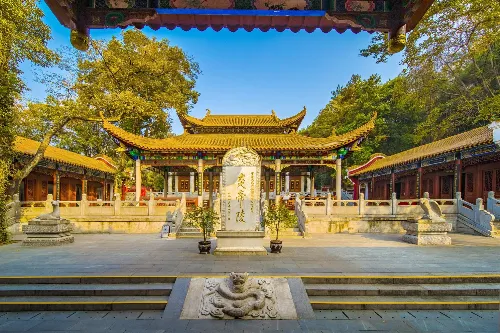
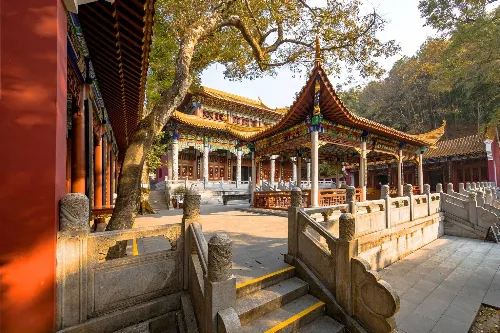
Shennong Grand Hall
Located on the east side of the central axis of Yandi Mausoleum Hall, Shennong Grand Hall serves as the public sacrifice zone of the first phase of the Yandi Mausoleum project. Construction started in 2001 with an investment of over 70 million yuan, and it was completed and put into use in September 2002. Covering a total area of more than 20,000 square meters with a building area of 1,413 square meters, it is an antique building in the Qing Dynasty style. The main hall is 37 meters wide, 24 meters deep and 19.6 meters high, consisting of the main hall, auxiliary halls on the east and west sides, connecting corridors and two square pavilions. Ten high-relief coiled dragon granite pillars stand in the outer corridor of the main hall. Each pillar is 5.4 meters high and 0.8 meters in diameter, with vividly carved coiled dragons, and is made of a single piece of granite from Fujian. In the center of the main hall stands a stone carving statue of Emperor Yan, holding an ear of grain in one hand and a plow in the other. The statue is 9.7 meters high, with a base 8.9 meters long and 4.7 meters wide, carved from red granite from Guangze, Fujian. The left, right and back walls of the main hall are decorated with large-scale red sandstone carvings from Guangdong. The carvings range from 5.2 to 7.9 meters in height, with a total length of 53 meters and a total area of 321 square meters, depicting the ten great achievements of Emperor Yan.
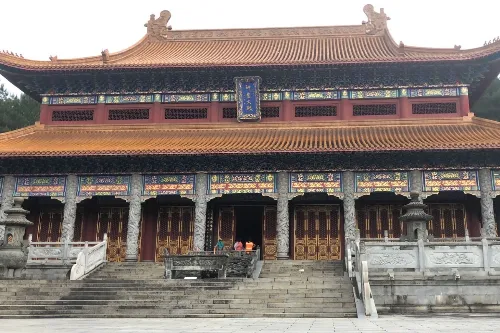
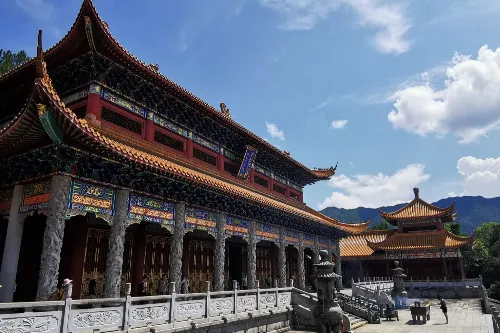
Imperial Stele Garden
Located behind Emperor Yan's tomb mound and to the north of the central axis of Yandi Mausoleum Hall, the Imperial Stele Garden can be accessed via the archway paths on both sides of the Tombstone Pavilion behind the main hall. The garden is 100 meters long, covering an area of 6,400 square meters with a building area of 280 square meters. The stone tablet corridors are the main structures of the garden, standing on the east and west sides. As antique buildings with gabled and rolled-up eaves, the corridors stretch for a total of 84 meters. The walls are inlaid with 51 stone steles inscribed with imperial sacrificial texts from the Ming and Qing dynasties, as well as 5 representative commemorative steles from historical periods including the Song, Ming, Qing dynasties, the Republic of China and the People's Republic of China, totaling 56 steles. The Nine Tripods Platform is located in the center of the garden, with a round outer platform and a square inner platform. The round platform has a diameter of 18 meters, and the square platform is 9.999 meters in length. Nine square granite tripods are placed on the platform, each weighing 1.2 tons. The nine tripods symbolize the supreme power of the state.
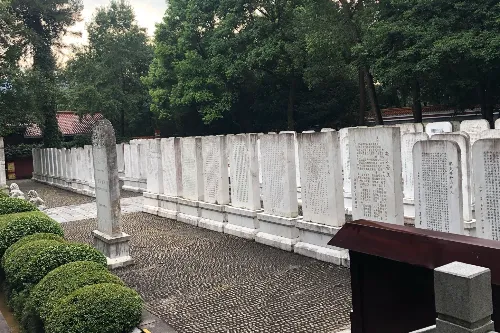

Sacred Fire Platform
Situated on Longzhu Mountain south of Shennong Grand Hall, the Sacred Fire Platform stands on the east side of the sacrificial avenue, with the Yongfeng Platform on the west side. It was built in 1993 to ignite the sacred fire for the first "Yanhuang Cup" Series Dragon Boat Races for Global Overseas Chinese. The platform is 40 meters high. In the center of the platform stands a 3.9-meter-high, 31-cubic-meter reddish-brown fire-igniting stone. A 1.5-meter-high vermilion pictographic character "Yan" (meaning flame) is carved on the front of the stone, resembling a burning torch. In 1993, Yuan Longping lit the sacred fire for the "Yanhuang Cup" Series Dragon Boat Races for Global Overseas Chinese here.
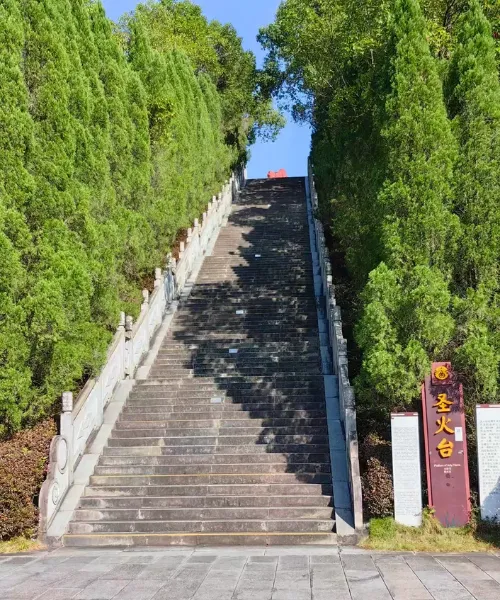
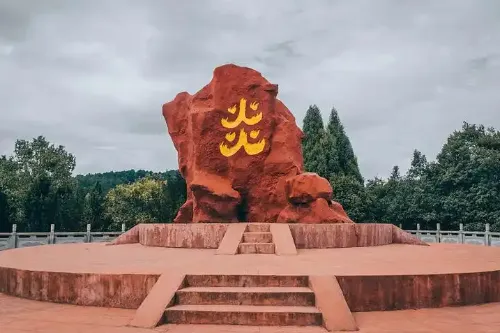
Shennong Garden
Located in the Commemoration Zone, Shennong Garden is planted with various medicinal herbs. It not only allows visitors to learn about Emperor Yan Shennong's great achievement of tasting hundreds of herbs and inventing traditional Chinese medicine, but also enables them to appreciate various rare plants and feel the charm of nature. Wandering in the garden, one can feel as if traveling through time and space to communicate with the wisdom of the ancient times.
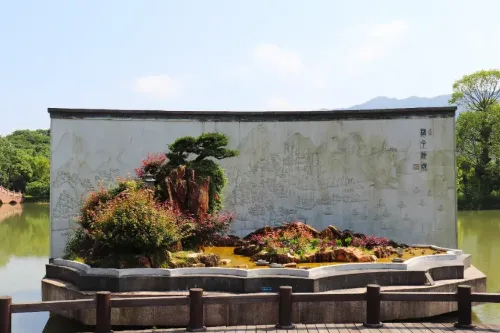
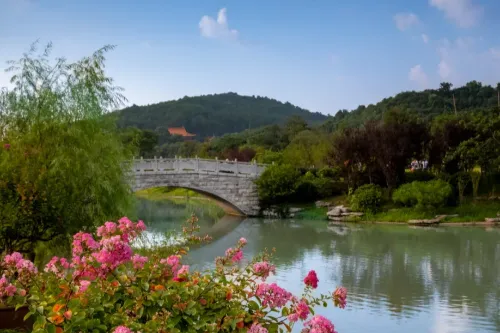
Recommended Tour Route
A recommended one-day tour route is as follows: In the morning, enter the scenic area from the entrance, first visit the Memorial Archway, then go to Huaxia Square, and then visit Eagle and Deer Square, Five Grains Pillars and Shengde Forest in sequence. Afterwards, proceed to Yandi Mausoleum Hall and visit the Meridian Gate, Ritual Pavilion, main Mausoleum Hall, Tombstone Pavilion and finally the tomb mound in order. In the afternoon, go to Shennong Grand Hall. Admire the sacrificial square in front of the hall and the stone circular incense burner carved with nine dragons playing with a pearl. Then enter the main hall to see the stone statue of Emperor Yan and the stone carvings on the three walls. Next, visit the Sacred Fire Platform and Yongfeng Platform. Finally, you can choose to visit Shennong Garden. The entire route is about 3 to 4 kilometers on foot, so it is advisable to wear comfortable shoes.
Travel Tips
- Spring (March - May) and autumn (September - November) are the best seasons to visit Yandi Mausoleum, as the weather is pleasant and the temperature is mild.
- If you wish to attend the sacrificial activities, you can check the scenic area's sacrifice schedule in advance and choose a suitable time to visit, so as to experience the solemn atmosphere of the sacrificial ceremonies.
- When visiting cultural relics such as Yandi Mausoleum Hall, it is recommended to hire a tour guide. Their explanations will help you gain a deeper understanding of Emperor Yan culture and related historical stories.
- During your visit to Shennong Garden, you can pay attention to the introduction signs of various medicinal herbs to expand your knowledge.
- There are some featured agricultural products for sale in the scenic area, such as yellow peaches and camellia oil. You can purchase them as needed, but please be careful to distinguish their quality.
Notes
- Most structures in the scenic area are ancient cultural relics. Touching or carving on the cultural relics is strictly prohibited. Please protect the scenic environment and do not litter randomly.
- Please keep quiet and solemn in sacrificial sites like Yandi Mausoleum Hall. Observe the sacrificial etiquette and refrain from making loud noises.
- During the visit, please follow the guide signs and designated routes, and do not enter unauthorized areas.
- If you choose to travel by self-driving, please plan your route in advance. Traffic around the scenic area may be congested during the peak tourist season, so it is advisable to depart early.
- If you visit in summer, please take sun protection and mosquito prevention measures, and carry necessary sunscreen products and anti-mosquito medicines.
Transportation
- By Air: You can first arrive at Changsha Huanghua International Airport. The airport is about 350 kilometers away from Yanling County. You can rent a car at the airport or take an intercity coach to Yanling County, then transfer to a shuttle bus to Yandi Mausoleum Scenic Area. The whole journey from Changsha takes about 4 - 5 hours.
- By Train: Take the train to Yanling Railway Station. After arriving, you can take a bus or a taxi to the scenic area, which takes about 30 minutes.
- By Coach: Intercity coaches from nearby cities such as Zhuzhou, Changsha and Hengyang directly reach Yanling County. After arriving in Yanling County, you can take a shuttle bus to the scenic area. The journey from Zhuzhou to Yanling takes about 3 hours, and from Changsha to Yanling takes about 4.5 hours.
- By Self-driving: Starting from Changsha, take Shanghai-Kunming Expressway and Wuhan-Shenzhen Expressway, exit at Yanling West Station, and then drive for about 20 minutes to reach the scenic area. The whole journey is about 350 kilometers, taking 4.5 hours. Starting from Zhuzhou, take Wuhan-Shenzhen Expressway, exit at Yanling West Station and head for the scenic area. The whole journey is about 200 kilometers, taking 3 hours. The scenic area has a parking lot, with a charging standard of 10 yuan per day for compact cars, 15 yuan per day for medium-sized cars and 20 yuan per day for large-sized cars.
Opening Hours
The scenic area is open all year round, with opening hours from 08:00 to 17:30. The specific hours may be adjusted according to seasons or special circumstances. It is recommended to check the official information of the scenic area before your trip.
Ticket Information
The ticket price is 62 yuan per person.
You can search for the official WeChat official account "湖南炎帝陵" to get the latest updates or buy tickets online.
Online Booking
Click here to jump to the Trip.com ticketing platform for ticket purchase.


